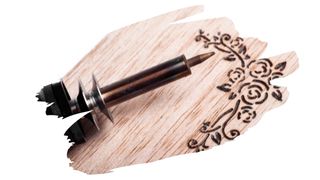Whether you’re fantastic at pyrography — or a complete beginner — when it comes to this art-form you should always make personal safety a priority.
Now, there are obvious precautions you need to take when it comes to wood burning. For example, working in a well-ventilated room and wearing a mask, are a must.
But, there is one extra thing that often gets looked over when people take up this craft…and that is the toxicity of the wood they are burning.
You see, a face mask can do a good job filtering out smoke particulates. Nevertheless, there are some toxic fumes that are too dangerous for you to risk getting a whiff of.
And when it comes to engineered materials, like plywood, these materials hide some fairly toxic chemicals inside them.
So, in this post, you will learn what really goes into the manufacture of plywood. You’ll also learn why burning, (and re-vaporizing), the adhesive inside plywood is NOT a good idea.
And keep reading to discover which affordable north American hardwood provides the best canvas for your pyrography designs.

This post may contain affiliate links to products that we receive a commission for (at no additional cost to you). Learn more here.
What Is Plywood Really Made Of?
Plywood is a manufactured wood made up of wooden ply sheets that are held together using a strong adhesive.
Now, the exact type of wood used to make plywood varies. Different types of timber, from Birch to Maple to Douglas Fir, are used to make this engineered wood.
But what they all tend to have in common, is the type of glue used to hold them together. The glue used in a standard sheet of plywood is called phenol-formaldehyde. And this adhesive contains formaldehyde.
Is Phenol-Formaldehyde Toxic?
Well, the formaldehyde contained in this glue certainly is toxic. Particularly when it is in the form of a vapor.
In fact, phenol-formaldehyde glue is at it’s most toxic when it is still off-gassing.
Off-gassing refers to the gaseous fumes that drift off wood finishes, glues, and paint, as they dry. These fumes are referred to as VOC’s (Volatile Organic Compounds). And it can often take weeks for wood finishes or paints to stop off-gassing.
And the same is also true of phenol-formaldehyde adhesives. These particular glues can take up to 24 months before they stop releasing significant amounts of VOC’s into the air.
However, if you buy your plywood from a store, it has likely already finished off-gassing before you purchased it. That’s because it has had time to sit in the store and dry out in the shop, before you got it.
Related Post: A Quick Beginners Guide To BCX Vs RTD Plywood
So Is It Safe To Burn Plywood? Or Is Plywood Simply The Worst Wood For Pyrography?
Here’s the thing; plywood contains a lot of chemical glue. And burning plywood doesn’t just melt plywood’s adhesive, it also effectively vaporizes it.
That vaporizing glue is the main reason why you should never burn plywood for firewood. And it is also why you should not risk wood burning designs into plywood either.
What’s more, plywood also tends to be pressure treated, especially if it’s exterior graded.
Pressure treatment is a milling process that involves infusing wood with rot-resistant water-soluble chemical wood preservatives. So, if your plywood board has also been treated, then it may contain even more potentially noxious chemicals in its plies.
You’ll know your plywood has been treated if it has a PT (Pressure Treated) or GC (Ground Contact) stamp on it.
Related Post: Can You Use Pressure Treated Wood For A Bed Frame?
Is There A Formaldehyde-Free Plywood I Can Use Instead?
Well, there are plywood sheets you can buy that are formaldehyde-free. Marked as NAF (No Added Formaldehyde) Plywood, these specialized boards are glued using a natural-alternative soy-based adhesive.
If you can get some untreated NAF plywood, then you can safely use it for pyrography.
However, this formaldehyde-free alternative plywood is much more expensive than your standard plywood. Which is why you’re better off simply purchasing and using natural solid wood for wood burning instead.
OK. So What Is The Best Wood For Pyrography?
The best choice for timber for pyrography is easily Basswood. Not only is it cheap and accessible, it’s fine grain also provides the perfect canvas for your designs.
And Is Basswood Really That Good For Pyrography?
Absolutely it is. The tight grain of this hardwood is very pale, which allows for a great contrast against dark burn marks.
And its grain is barely noticeable, (unlike say Red Oak), so it won’t interfere with the clarity of your images either.
Related Post: Beginners Guide To Reducing Oak Grain Contrast (Explained)
Best of all, this wood doesn’t contain lots of resinous tree sap/pitch. So, you needn’t worry about tree resins boiling and messing up the lines of your most intricate drawings.
And Where Can You Go To Buy Basswood For Pyrography?
The best place to buy this hardwood is either online, or at your local lumber mill.
Basswood, (aka the American Linden or Lime), grows natively in North America. So, there are plenty of suppliers of this hardwood everywhere.
And if you want a stack of oval Basswood rounds, then check out Wilson Enterprises Store online.
Sourced from Michigan (USA), Wilson’s untreated kiln-dried Basswood rounds can be used for everything from wood burning to wood carving.
You can learn more by checking out the latest prices for these Basswood rounds over on Amazon.com
To Wrap Up, Here Are The 3 Key Takeaways From This Post…
1). Plywood is made using chemical adhesives that contain formaldehyde. So, plywood is not safe to use for wood burning.
2). There are formaldehyde-free plywoods that you can buy. However, they are very expensive to get a hold of.
3). The best wood for wood burning is Basswood, which is much more affordable. Plus, it’s pale uniform grain provides the perfect canvas for your artwork.
References:
Long-term Impact of Formaldehyde and VOC Emissions from Wood-based Products on Indoor Environments | Sagepub.com
Formaldehyde | American Lung Association



